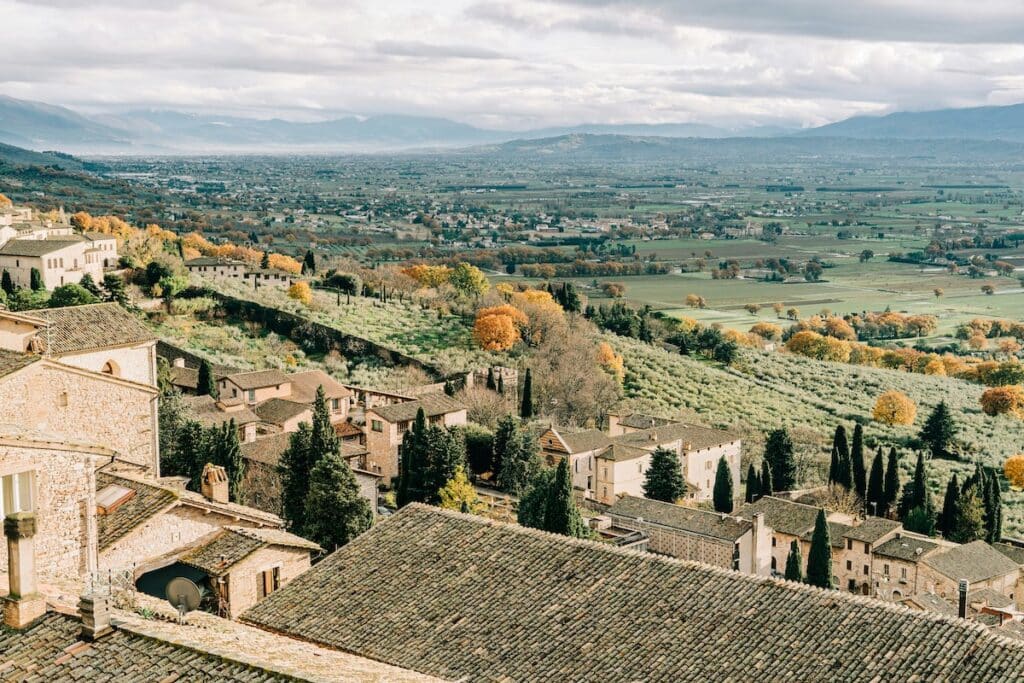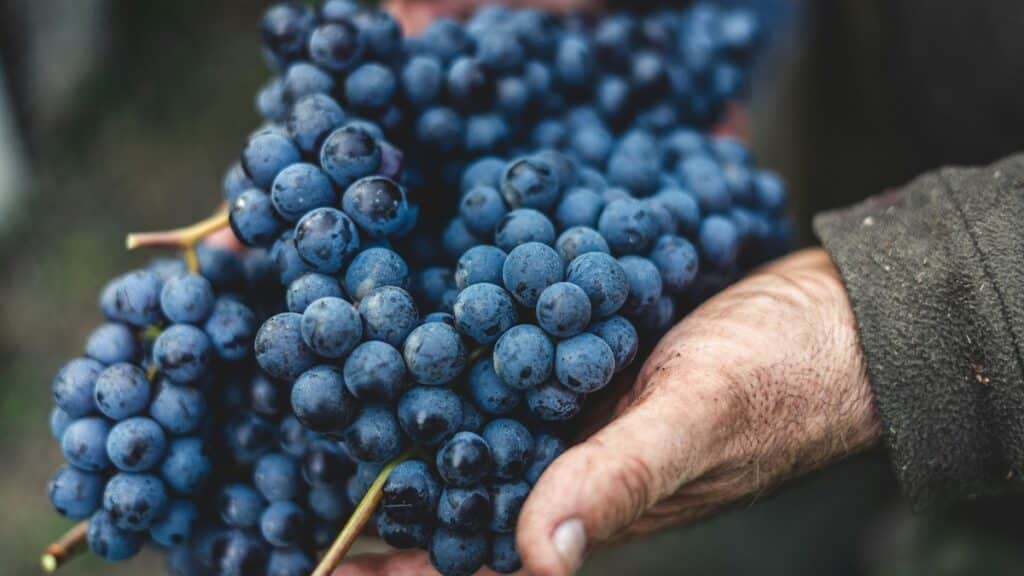Tuscany? Been there, done that (or maybe it’s on your bucket list). But what about Umbria? Tuscany’s neighbor is full of charm, and will give you a taste of authentic Italy.

Do rigid itineraries and over-crowded attractions leave you yearning for something more immersive and authentic? Then Umbria, with its unhurried pace and genuine charm, is your Italian dream come true.
Umbria offers its own kind of magic: fewer crowds, beautiful landscapes, and plenty of culture to explore.
Don’t get me wrong…I am absolutely in love with Tuscany (it’s actually my second home). But with the number of tourists in Italy growing exponentially every year (there were 60 million in 2023!), it can be difficult to find those iconic “Under The Tuscan Sun” moments that many of us dream of.
Here are 7 reasons why should consider a visit to Umbria.
1. Escape The Crowds

Tuscany’s beauty is undeniable, but its popularity has led to almost constantly crowded towns and attractions.
Imagine trying to get the perfect picture of the Leaning Tower while being surrounded by hundreds of people. Or trying to make your way through a beautiful piazza packed full with tourists in Florence on a sweltering summer afternoon, all while trying to avoid being pickpocketed.
In Umbria, you can explore the quaint towns and countryside without worrying about large crowds or navigating through a packed piazza.
You’ll be a traveler, not just another tourist in a crowded destination.
2. Budget-Friendly: Stretch Your Euros Further
Tuscany’s popularity also means higher prices. Umbria offers a more budget-friendly alternative.
There are plenty of affordable agriturismos and hotels, and you’ll find fantastic local restaurants serving up delicious, authentic Italian food without burning a hole in your wallet.
Enjoy incredible food and regional wines – all without feeling like you’re overspending.
3. A Medieval Time Capsule

Umbria isn’t just stunning scenery; it’s a journey through time.
This region boasts one of the highest concentrations of medieval towns in Italy.
You can explore these living museums, where you can walk along the same cobblestone streets that pilgrims, merchants, and knights once roamed.
And the medieval architecture is well-preserved, from the winding streets and narrow alleys to the impressive castles and fortresses.
Here are just a few of the towns you can explore:
Assisi:
Nestled on a hillside, Assisi is Umbria’s crown jewel. This charming town, birthplace of St. Francis, radiates spiritual significance. Explore the magnificent Basilica of San Francesco, a UNESCO World Heritage Site adorned with breathtaking Giotto frescoes. Lose yourself in the maze of narrow alleys and soak up the timeless charm of this unforgettable town.
Orvieto:
This hilltop town is a sight to behold, with its stunning Duomo dominating the skyline. The medieval streets are lined with charming cafes and artisan shops, perfect for finding one of kind souvenirs or enjoying a coffee or spritz. Don’t miss the underground caves and tunnels that date back to Etruscan times – a unique and fascinating experience.

Gubbio:
Nicknamed the “City of Fools” for its unique medieval festival, Gubbio offers a captivating blend of history and whimsy. Ascend Mount Ingino by cable car for panoramic vistas. Explore the massive Palazzo dei Consoli, a symbol of Gubbio’s medieval power. Don’t miss the Piazza Grande, the central stage for life in this beautiful town.
Spello:
The town of Spello is known for its colorful flower displays and quiet charm. Every spring, its streets erupt in a colorful spectacle with the Infiorata, a floral art festival transforming the town. Beyond the flowers, get lost in Spello’s medieval alleys, see its Roman amphitheater, and visit the hilltop cathedral which offers a breathtaking view of the valley.

Spoleto:
A treat for history buffs, Spoleto charm is a combination of Roman, medieval, and Renaissance influences. Visit the impressive Ponte delle Torri, a Roman aqueduct bridge, and climb the Rocca Albornoziana, a 14th-century fortress with stunning views. Don’t miss the Duomo, a beautiful cathedral featuring Romanesque and Gothic architecture.
Perugia:
Visit Perugia, the lively capital of Umbria and a historic university town. See the impressive Cathedral, check out the Etruscan Gate, and stroll through the medieval streets. Be sure to attend Eurochocolate, the annual mid-October festival celebrating everything cocoa!
Bevagna:
Step back in time in Bevagna, a perfectly preserved medieval town. Stroll along the Roman Forum, admire the 13th-century church of San Francesco, and soak up the authentic Italian atmosphere. Bevagna is a treasure for those seeking an off-the-beaten-path experience.
Castiglione del Lago:
Perched on Lake Trasimeno’s shores, Castiglione del Lago offers a blend of medieval charm and lakeside tranquility. Explore the fortress of Rocca del Leone, wander the historic center, and enjoy stunning lake views.
4. A Simple But Hearty Food Experience

Travelers can look forward to indulging in hearty, soul-warming dishes that are deeply rooted in tradition yet timeless in their appeal.
Umbrian cuisine celebrates the art of slow cooking, with specialties like “porchetta” (roasted pork) and “torta al testo” (a type of flatbread) that have been passed down for generations.
Some other foods that are unique to the region are “crescia al formaggio” (a savory cheese-filled flatbread), “umbricelli” (thick hand-rolled pasta served with a rich meat sauce), and “truffles,” which grow abundantly in the region and are prized for their earthy, delicate flavor.
5. Unique Wines
Tuscany’s vineyards may be world-famous, but Umbria offers a thriving wine scene with its own distinct charm. Here, the spotlight shines on indigenous grape varietals, crafting wines that are unique and brimming with character.
Sagrantino’s Power: The undisputed king of Umbrian wines, Sagrantino is a bold and robust red grape. These wines are known for their high tannins, intense flavors of black fruit and spice, and remarkable aging potential.

Montefalco’s Elegance: For a more approachable red, explore Montefalco Rosso, a blend of Sangiovese, Sagrantino, and other local grapes. These medium-bodied wines boast bright cherry and plum flavors, perfectly complementing various Umbrian dishes.
Beyond Reds: Don’t miss Umbria’s white wines! Discover refreshing options like Orvieto, made primarily from Trebbiano grapes. Orvieto Classico ranges from dry to slightly sweet, offering a versatile choice for any meal. For something truly unique, try Grechetto di Todi, a white wine known for its floral aromas and crisp acidity.
Unforgettable Wine Experiences: With so much to discover, consider a wine tasting tour. Explore beautiful wineries nestled in the rolling hills, meet passionate winemakers, and learn about Umbria’s rich winemaking traditions.
6. A Spiritual Haven: Following in the Footsteps of St. Francis
Umbria isn’t just a beautiful region; it’s also a place of deep spiritual significance. As I mentioned earlier, Assisi is the birthplace of St. Francis, a beloved saint known for his devotion to nature, peace, and poverty.
It’s hard to explain with words, but there is a peacefulness that truly permeates every corner of this exceptional town. It’s one of my favorites that I’ve returned to several times.

Assisi draws pilgrims from all over the world, seeking inspiration and connection with St. Francis’ legacy.
Explore the Basilica of San Francesco: This magnificent basilica is adorned with breathtaking frescoes by Giotto that depict the life of St. Francis.
Tranquil Gardens: Wander through the peaceful Basilica’s gardens, a place of reflection and tranquility.
Whether you’re a devoted follower of St. Francis or simply seeking a place of peace and contemplation, Assisi will leave a lasting impression.
7. A Cradle of Art and Culture
While Tuscany may be synonymous with Renaissance masters, Umbria boasts a rich artistic heritage all its own.
Perugia: A City Steeped in Art: Perugia, the vibrant capital of Umbria, is a haven for art lovers. Visit the Galleria Nazionale dell’Umbria, which houses an impressive collection of Italian paintings and sculptures from the Middle Ages to the Renaissance. You’ll see masterpieces by Perugino, Signorelli, and Pinturicchio, all of whom left their mark on Umbria’s artistic heritage.
Beyond the Gallery: Perugia has many artistic treasures beyond the National Gallery. Visit the elegant Palazzo dei Priori, filled with frescoes and sculptures. Discover hidden churches like San Pietro, rich in Renaissance art.
Treasures Beyond Perugia: Umbria’s artistic offerings extend far beyond Perugia. In Spello, explore Santa Maria Maggiore, a church adorned with frescoes by Pinturicchio. Art lovers shouldn’t miss the Pinacoteca Civica in Spoleto, showcasing works by Fra Filippo Lippi and Lorenzo Salimbeni.
Beyond Paintings: Umbria’s artistic heritage includes more than just paintings. In Deruta, a charming town near Perugia, you can explore the centuries-old tradition of ceramic making. Visit workshops, see the artistry firsthand, and even take a pottery class to create your own Umbrian souvenir. For a modern art experience, visit the Giardini dei Lauri in San Terenziano. This sculpture garden, set among rolling hills, features works by contemporary artists and offers a fresh view of Umbria’s art scene.
Conclusion
Looking for an authentic Italian escape? Look no further than Umbria. Skip the crowds and discover a region steeped in history, art, and stunning scenery. Explore charming villages, delve into artistic treasures, and savor delicious local wines and cuisine. Umbria offers a unique Italian experience – a hidden gem waiting to be explored. Think you might want to add it to your travel list?
Further Reading
Planning A Trip To Italy: The Ultimate Guide
When Is the Best Time To Go To Italy?
39 Things To Know Before Traveling To Italy (So You’ll Feel Like A Local)




